
Introduction to Quantum Computing Threats
Quantum computers utilize the properties of quantum physics to perform calculations exponentially faster than classical computers. This has enormous potential to benefit humanity, such as enabling us to model complex phenomena like drug interactions and climate change. However, there is a dark side. Quantum computers will be able to easily break many of the encryption standards I rely on today. This necessitates a transition to “quantum-safe” encryption standards before large-scale quantum computers become a reality.
I need to understand the timeline for when this quantum threat will materialize. Experts estimate practical quantum computers capable of breaking common encryption schemes like RSA and ECC will emerge sometime in the next 10-30 years. The exact timing is uncertain, but the risk increases substantially over the next decade. This transition won’t happen overnight, but organizations must begin preparations now to avoid being caught off guard.
The Risks of Inaction
Ignoring the need to upgrade to quantum-safe encryption could have severe consequences in the long run. Once large quantum computers exist, an attacker could retroactively decrypt sensitive archived data encrypted with vulnerable standards. Any data I want to remain confidential for more than 10 years should be protected.
Vulnerable encryption also poses risks to real-time systems. Keys secured with breakable algorithms today could be decrypted in the future. An attacker could stockpile encrypted traffic now and decrypt it later once capable quantum computers exist. This store now, decrypt later strategy means I must proactively address this vulnerability before these machines appear.
Understanding Quantum-Safe Encryption Approaches
There are four main approaches to developing quantum-safe encryption:
Post-Quantum Cryptography
Post-quantum cryptography refers to developing new public key encryption algorithms designed to be secure against attacks from both quantum and classical computers. Examples include lattice-based and code-based cryptosystems.
Advantages of this approach include being able to reuse existing encryption frameworks like TLS and PKI. However, these new algorithms are less battle-tested than older standards. More research is still needed to evaluate their robustness.
Quantum Key Distribution
Quantum key distribution (QKD) is a process that uses quantum mechanics to generate and share random keys between two parties. This enables theoretically unbreakable encryption on communication channels.
While promising, current QKD technology is expensive and limited to distances under 100 km. It may eventually become a universal solution but is unrealistic for widespread use in the near future.
Quantum Cryptography
Quantum cryptography refers to using quantum mechanical effects directly to create cryptographic primitives. This includes approaches like quantum entanglement for randomness generation.
Like QKD, many quantum cryptography methods require advanced hardware not feasible for mass deployment. There is active research in this space, but practical applications are still years away.
Symmetric Key Algorithms
Well-studied symmetric algorithms like AES are considered quantum-safe, since quantum computers provide no advantage in breaking them. But the challenge lies in securely distributing secret keys, which currently relies on public key cryptography.
One option is hybrid encryption, using symmetric algorithms to encrypt data and quantum-safe public key protocols to share symmetric keys. This allows me to continue leveraging existing data encryption methods.
Transitioning My Organization to Quantum-Safe Encryption
Here are best practices to begin preparing my organization for the post-quantum world:
1. Review Encryption Inventory
Catalog all the encryption currently implemented, including protocols, key lengths, and expiration dates. This helps assess which systems most urgently need upgrading to quantum-safe alternatives.
2. Strengthen Key Management
Even if I must maintain some vulnerable algorithms like RSA for backwards compatibility, I can ensure keys are rotated frequently to limit how much data would be exposed if decrypted.
3. Test and Deploy Post-Quantum Cryptography
Add new quantum-safe algorithms like NewHope or Falcon alongside existing protocols. This provides defense in depth while ensuring compatibility with partners or customers who may be slower to upgrade.
4. Develop Migration Roadmap
Given the inventory of what needs changing and available post-quantum options, put together a plan to phase out vulnerable algorithms before devastating quantum attacks occur.
5. Keep Monitoring the Landscape
Quantum computing and cryptanalysis are fast-moving fields. It’s wise to continuously evaluate new standards and developments to adapt my roadmap as the threat evolves.
Conclusion
The emergence of quantum computing will make current widely used encryption standards obsolete. Organizations must begin to prepare now to avoid catastrophic data breaches. By taking inventory of existing cryptography, hardening key management, deploying post-quantum alternatives, and developing comprehensive migration plans, I can ensure my data remains secure in the quantum future. There is no time to lose in implementing these quantum-safe encryption best practices.












